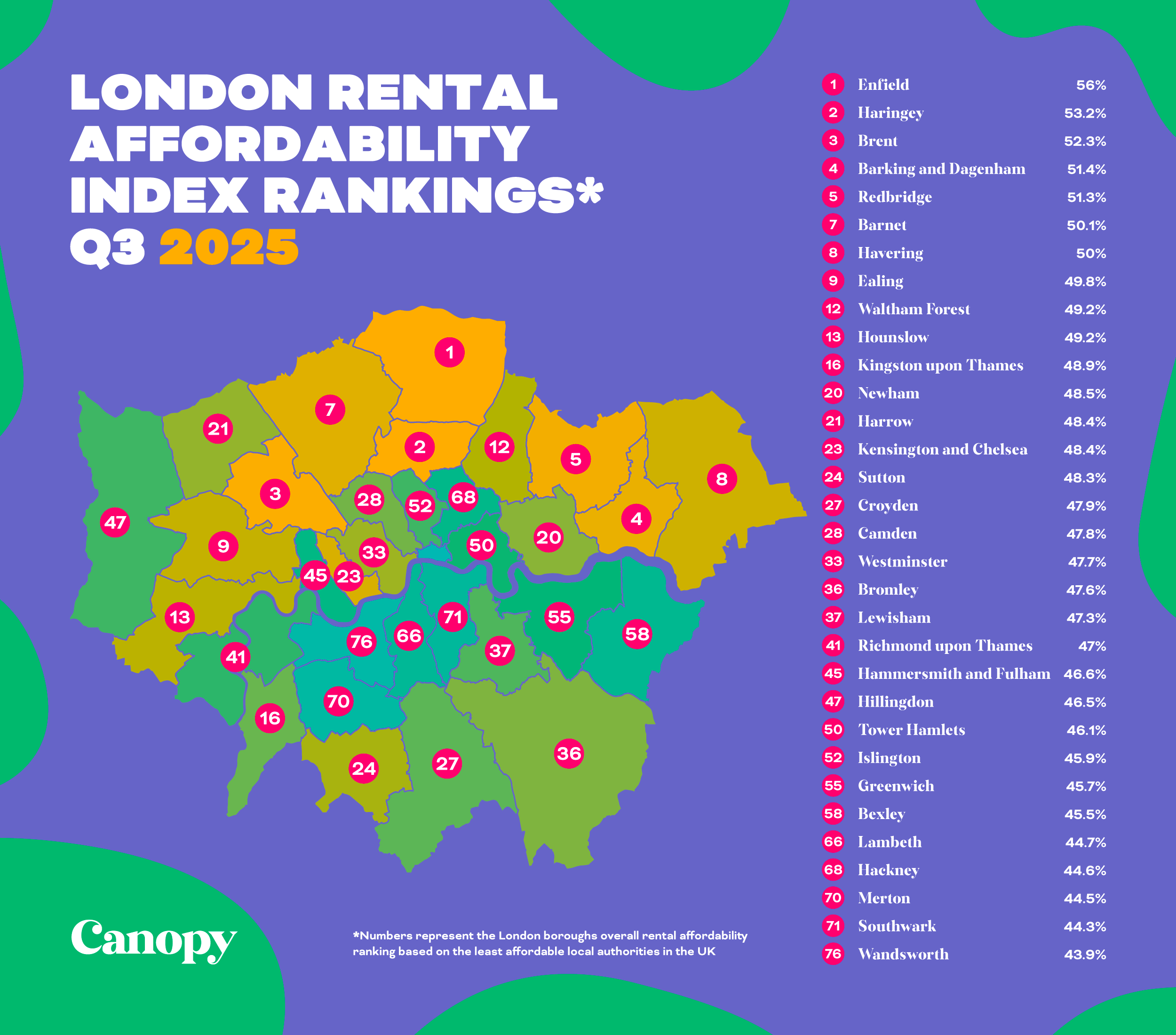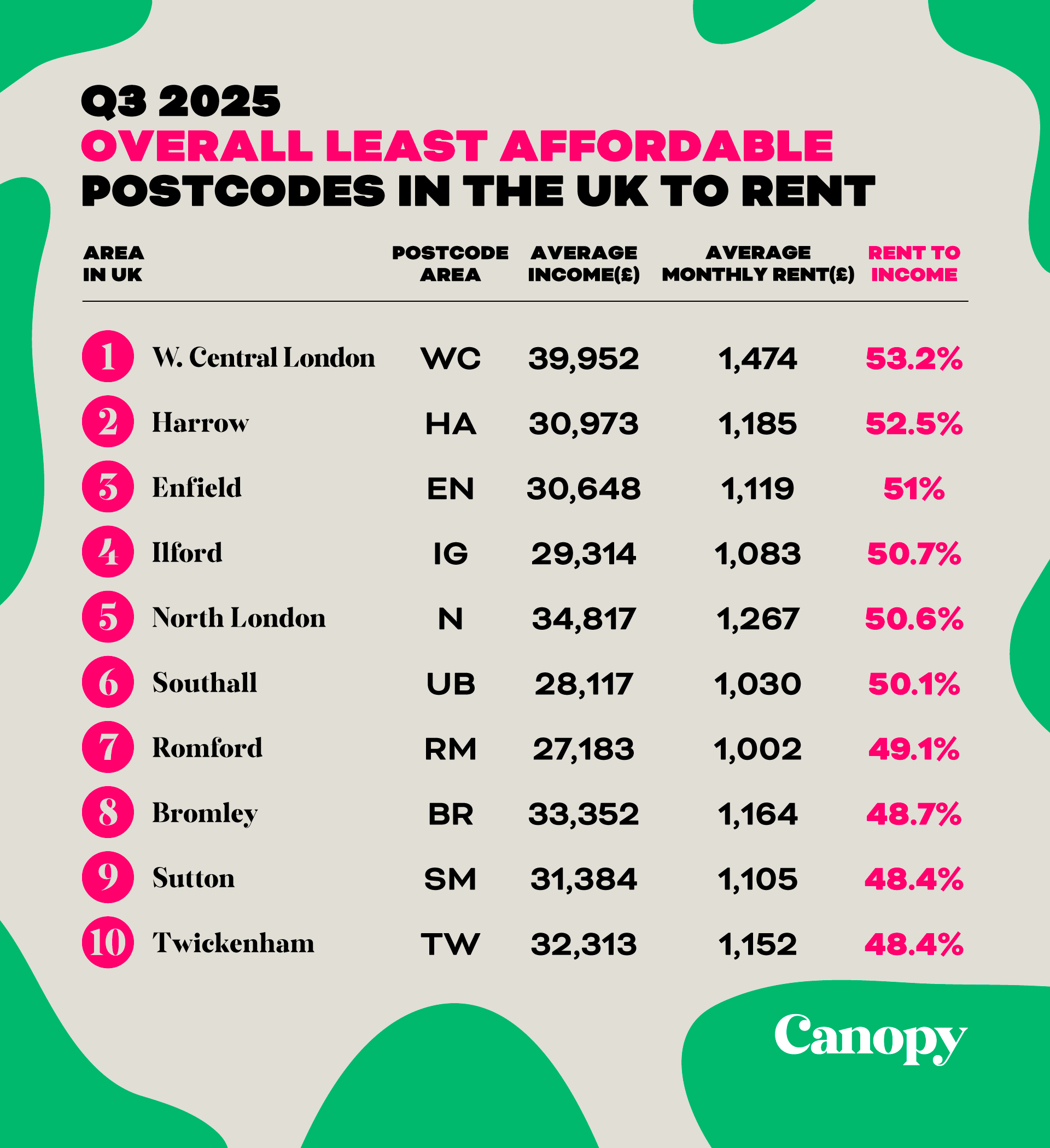Our latest Canopy rental affordability index covers quarter three in 2025 (July-September), with insights drawn from more than 112,000 individual renters on the Canopy database from across the UK.
The report measures the average take-home salary of employed tenants and compares them against rental costs to calculate a rent-to-income ratio – in other words, the percentage of income spent on rent.
UK renters continue to be on the edge of affordability
The Q3 index reveals that the average UK tenant is spending 41% of their monthly take-home pay on rent, a 5% year-on-year increase as affordable renting continues to be more difficult.
The average UK rent per tenant has increased by £16 per month since last quarter, now costing the average tenant £870 per month. This is also a £58 increase from last year.
What is clear to see is that the average UK tenant is continuing to spend over the odds for what is deemed affordable. The experts at Canopy suggest that spending 40% of take-home salary is considered the very outer limit of affordability; therefore, the majority of tenants are continuing to spend what is considered financially feasible or ‘comfortable’.
The figures become even more concerning at the extreme end of the scale. Nationally, 14% of renters spend more than half of their income on rent each month. A further 9% are spending more than 60%, and 6% allocate over 70% of their monthly income to rent.
The South vs The North
The report highlights the regional disparities in rent across the UK, with tenants in the South of England spending a higher proportion of their income on rent than those in the North of England.
Unsurprisingly, London has the least affordable rent-to-income ratio, with renters spending nearly half (47.7%) of their take-home pay on rent.
South East England, which is home to cities like Brighton, Oxford and Canterbury, follows closely, with tenants spending on average 43.8% of their income on rent.
The North East of England remains the most affordable region, with tenants spending on average 33.9% of their paycheck on rent, 10% less than the South East.
North West and Yorkshire & Humber are emerging as the best places to rent
It isn’t all doom and gloom within the rental affordability crisis though, as two regions in particular are seeing an improvement.
The North West and Yorkshire & Humber stand out as the best regions for renters who also want to put money aside. Both areas combine comparatively low rent-to-income ratios with strong and resilient local economies, making them attractive to young professionals, families, and those looking to climb the property ladder.
In the North West, the average monthly rent has dropped from £727 in 2024 to £707 in Q3 2025, easing slight pressure on household budgets. The region benefits from cities like Manchester and Liverpool, which offer strong employment opportunities, alongside smaller towns where rents remain even more affordable.
A similar trend is visible in Yorkshire & Humber, where average monthly rents have fallen from £648 to £624 over the same period. With cities like Leeds, Sheffield and Hull offering a balance of job opportunities and affordable housing, renters in the region are better placed to manage costs while still maintaining a good quality of life.
The age disparity across the UK
Affordability challenges are not only seen regionally but also vary significantly by age group. Younger renters face the steepest financial strain, with those aged 18-25 spending on average 48.4% of their income on rent. This means nearly half of their monthly earnings are going straight to landlords, leaving little room for savings or other essentials.
For renters aged 26-35, the proportion falls to 39.7%, reflecting how increased earnings and career progression typically ease financial pressure. However, the data reveals a surprising turn for those in the 36-45 age bracket, who spend slightly more at 40.1% of their income on rent. This could potentially be due to lifestyle changes, such as moving into larger family homes, or stagnating wage growth not keeping pace with housing costs.
London analysis
In London, tenants in seven boroughs spend over half of their income on rent, all of which are located in either North or East London.
Enfield remains the least affordable borough, with tenants spending on average £1,143 a month, equivalent to 56% of their income.
The map below shows how London boroughs rank for rental affordability compared to all UK local authorities. Of the ten least affordable local authorities nationwide, eight are London boroughs. In fact, every London borough has a rent-to-income ratio above the national average of 41%.
Wandsworth, in South West London, continues to be the most affordable borough in the capital. However, tenants there still pay more in absolute terms than those in Enfield, with an average rent of £1,262 a month. Thanks to higher incomes, this equates to the average tenant’s 43.9% earnings

Hull remains the most affordable city to rent in the UK
Hull continues to offer the best value for money for renters, as it takes the hotspot for being the most affordable city to rent in the UK once again. On average, tenants in Hull spend £554 a month on rent, equivalent to 31.9% of their income.
The top ten list for most affordable cities stays the same as last quarter, with Doncaster coming out second in the rental affordability rankings (32%), followed by Durham (32.5%) and Carlisle (32.9%).
At the other end of the scale, the ten least affordable cities in the UK all exceed the 40% rent-to-income threshold, above which housing is generally considered unaffordable. Brighton takes second place after London, with tenants spending 45.9% of their income on rent each month. Close behind are Oxford (45.4%), Bournemouth (45%) and Canterbury (44.5%).
In other major cities like Manchester, Birmingham and Leeds, tenants are spending around the same as last quarter. On average, tenants in Manchester allocate 39.4% of their income to rent, while those in Birmingham spend slightly less, at 38.3%. In Leeds, the figure is lower still at 35.7%.
The data highlights the ongoing regional divide in rental affordability. None of the ten most affordable cities are in the South of England, which remains the most expensive part of the country for renters. The most affordable cities are located across Yorkshire and the Humber, North East England, North West England and the West Midlands.

London postcodes remain the least affordable areas to rent in the UK
Unsurprisingly, all ten of the UK’s least affordable postcodes are still found in the capital.
Western Central London, which is home to popular areas like Covent Garden, Soho and Chelsea, continues to be the most expensive postcode to rent in the UK. Here, tenants pay on average £1,474 per month on rent, equivalent to 53.2% of their income.
Harrow follows closely in second at 52.5%, with Enfield ranking third at 51%.

Most affordable postcodes to rent in the UK
By contrast, postcodes in Northern England and Scotland dominate the affordability rankings, with all ten of the cheapest areas to rent found in these regions.
For those living in a DG postcode area, you are most likely still paying one of the most affordable rents in the UK. Dumfries remains the most affordable area in the UK to rent, with tenants spending just 31% of their income on rent.
Smaller cities such as Darlington, Kilmarnock and Carlisle also stand out among the most affordable postcode areas, with tenants typically spending less than a third of their income on rent. On average, tenants in Darlington spend 32%, while those in Carlisle and Kilmarnock pay slightly more at 33%.

Gary Barker, CEO at Canopy, commented:
“Our Q3 Rental Affordability Index shows tenants across the UK are under sustained financial pressure, with many in London spending over half their income on rent.
With tenants staying in properties longer and the courts under pressure, the focus must be on securing reliable tenants from the outset. High-quality referencing, backed by Rent & Legal Protection, gives landlords and agents the confidence to protect their income and safeguard tenancies.
Legislation like the Renters’ Rights Bill is welcome, but it won’t fix affordability or supply challenges alone. Until more homes are built, robust referencing and financial protection remain the most effective way to support both landlords and renters. At Canopy, we’re committed to driving this shift — delivering smarter, data-led solutions that strengthen trust and resilience across the rental market.”
Read more on how to make the most of your finances
Rental affordability is an ever-growing challenge for many, and we’re here to help both tenants and landlords tackle this and other issues that can arise in the competitive and evolving UK rental property market. Our RentPassport provides a digital footprint that can take the hassle out of the process for renters, making tenant referencing for letting agents and landlords.
Next time you move, all you need to do is show letting agents and landlords your RentPassport, which shows your previous rent history and puts their mind at ease to give you the green light without worrying about affordability. Check out our resources page for more information and advice on all things rent.

.png)
.png)